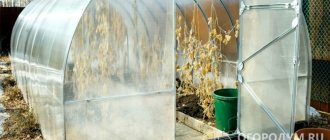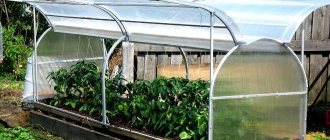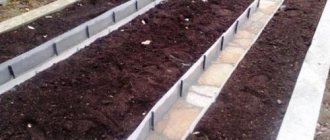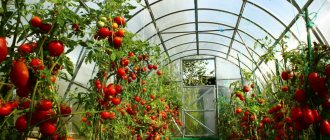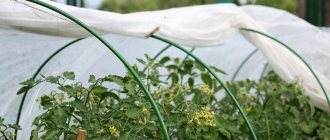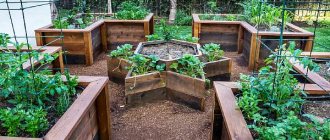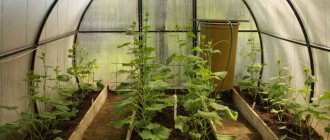The beds in a greenhouse 3 by 6 meters have their own design nuances. Today we will look at all the features in more detail, we will pay attention to the arrangement of beds in two and three rows, their location in the greenhouse. Then, taking into account all the advice, gardeners will be able to place the plantings in the most successful way. It will be comfortable to work in the greenhouse.
Beds in a greenhouse 3 by 6
Arrangement of beds in greenhouses 3 by 6
Typically, compact greenhouses 3x6 m are widely in demand in suburban and summer cottage areas. Here are the key features of such greenhouses.
- The greenhouse must be placed in an open place. It is important to organize a convenient approach to it.
- The beds usually run along the long sides, along the walls.
- For better and longer-lasting lighting, the long side should be facing west.
- It is important to create conditions for comfortable care of the beds. The height of the ridges relative to the path is usually a maximum of 40 cm.
- It is advisable to leave paths at least 45 cm wide. Only in such conditions is full-fledged effective work possible.
- It is better to make beds 60 or 90 cm long. Wider beds are used with paths on both sides, and when approaching from one side, beds 60 cm wide are suitable.
Optimal width of beds in a greenhouse
It is important! It is necessary to take care of the proper width of the paths. If they are too narrow, it is inconvenient to walk on them, there is no place to mark the necessary equipment, inventory, watering hoses, and the integrity of the beds will be constantly compromised. It is much more convenient to work with wide paths.
Greenhouse made of polycarbonate 3 by 6
Advice from experienced gardeners
Some tips for growing tomatoes will help you get a bountiful harvest, and will also help you avoid common mistakes of novice gardeners:
- at present, perhaps, the best material for greenhouses is polycarbonate - it is light in weight (no capital foundation is needed), easy to install and dismantle, has excellent technical characteristics, and has an affordable price;
- The temperature in the room, as well as the presence of drafts, depend on the direction of the wind. It follows that tomatoes that do not tolerate sudden changes in temperature should be planted near the walls of the room;
- An important factor in the growth of any plant is lighting. Varieties and hybrids that need more light are placed on the sunny side;
- in a limited space, it is more advisable to grow varieties with different characteristics, combining and combining low-growing with tall, light-loving and shade-loving ones. This way you can use the space to the maximum, creating all the plants the conditions they need;
- tall ones are placed next to the walls, short ones are placed closer to the aisles. This approach will not interfere with caring for tall bushes; you just need to lend a hand. At the same time, you will not need to reach for the low ones, making your way through the high ones, because they are nearby;
- in those regions where the spring weather is changeable and capricious, they equip high, or better yet, warm beds;
- for growing early vegetables, or year-round, beds are built about 80 cm high. On the same beds, vegetables are cultivated without seedlings;
- Do not use fresh mullein for fertilizers - it burns the root system of plants.
Read more about when and how to properly harvest tomatoes in a greenhouse.
The correct use of agrotechnical techniques when growing plants in a greenhouse, as well as the timely application of the necessary fertilizers, are not all the measures necessary to obtain a decent harvest. It is equally important to properly equip the greenhouse: this will help make the most of the entire useful volume of the room and make your work easier.
We arrange the beds rationally
There are several simple secrets to the proper arrangement of beds.
- For example, it is advisable to plant tall varieties in two rows. They are formed into several stems, and a gap of 80 cm is left between the rows.
- A good solution is to combine different varieties. Tall crops are planted in the center of the greenhouse, and low-growing crops are planted on the sides. It’s great when vegetables ripen at different times. Then you can collect a fresh harvest for a longer period.
- If the greenhouse is not made of polycarbonate, but double bubble, with reinforced film, you can also achieve a high yield. To do this, you will need low-growing varieties, if we talk about, say, tomatoes. The rows are formed into two and three stems, without stepsons. It is most effective to grow early ripening varieties under such conditions. A good solution is to plant the bushes in a checkerboard pattern. In this case, it is necessary to leave free space between the rows (approximately 50 cm).
Scheme of tomato formation in a greenhouse.
- When there are only two beds in the greenhouse, the two-row staggered method and the single-row method work well. All this will depend on the specific type of plant.
- If there are three beds in the greenhouse, but the dimensions are modest 3 by 6, you need to plant the crops in one row on the sides, and make two rows in the central bed. This is the optimal solution, providing maximum compactness and comfort. At the same time, the plants must be comfortable in the greenhouse, they must receive the necessary space and nutrition.
Option with three beds (in the center)
It is important! Remember the key principles for choosing the optimal planting pattern. It is necessary to rationally use the entire area of the greenhouse, and be sure to provide free access to every bush, plant, and branch. In addition, the conditions for the plants themselves must be the best - so that there is enough light and nutrition.
Stationary beds at waist level
How to calculate the required number of bushes depending on the type
The size of the building, the number of seedlings and its placement also depend on the type of plant. The size of the foliage and the spreading of the branches will determine the distance between the tomatoes in the greenhouse.
If the bushes are planted too densely, they will not be able to develop normally. The shoots and leaves will be small, the foliage will quickly turn yellow. It will either not be possible to harvest a harvest from such bushes, or it will not be very large. There will be few fruits, they will be small.
In dense plantings, plants are most susceptible to diseases, since they are initially weakened. In addition, in soil with a large number of roots, the circulation of air and moisture is worse, which means it is more susceptible to the formation of fungus and mold.
There are several types of tomatoes:
- Spreading species.
- Dwarf and low-growing tomatoes.
- Medium-sized tomatoes.
- Tall tomatoes.
- Spreading species are the most demanding in terms of distance between each other. They grow both upward and wider, developing long branches with large leaves. For a 3X4 meter greenhouse, no more than 12 bushes are suitable, and 12-16 seedlings can fit in a 3X6 meter building. The distance between them should be about 50-70 centimeters. They are planted in the garden bed in one line.
- Dwarf varieties with a height of no more than 80 cm. Here the question at what distance to plant tomatoes is less important, since these species are planted more closely.
They do not have extensive foliage, so they are planted 2 seedlings in one hole. The distance between the holes should be about 40 centimeters. The greenhouse can accommodate about 100-160 bushes. The small size of the plants allows them to be planted in two lines in the garden bed. Obviously more seedlings are planted, and after a couple of weeks they are thinned out. At the same time, weak plants or those that have not taken root are removed. - Medium-sized tomatoes have a height of about 150 - 160 cm. They are planted in two lines in a checkerboard pattern, which allows you to place the largest number of plants. The distance between the holes when planting should be about 45-55 centimeters. This will allow the plants to develop normally. With this scheme, it is possible to place 40–50 bushes.
- Tall tomatoes are optimal for a greenhouse. They grow in height, their height is 180 - 200 cm. Thanks to this, it is possible to collect the largest number of tomatoes from one stem. They are planted in a checkerboard pattern at a distance of 40-45 centimeters from each other. In this way, it is possible to plant 30-45 bushes.
The most successful option for a greenhouse is tall varieties.
We plant tomatoes in a greenhouse measuring 3 by 6 meters
In the summary table we will look at the key features of planting crops. As an example, we take planting tomato bushes in a polycarbonate greenhouse. We will pay attention to the features, key characteristics of planting, as well as the method of planting. We will also indicate approximate calculations for two and three beds in a greenhouse 3 by 6 meters.
Growing tomatoes in a 3x6 meter greenhouse
Table. Features of planting tomatoes in a polycarbonate greenhouse.
| Index | Two beds | Three beds |
| Peculiarities | It is better to place the beds along the long sides. Then the width of the bed will be approximately 100 cm, and the rest of the area will be needed for the path. | A more convenient option with efficient use of space. You can make the paths a little wider by narrowing the beds. |
| Disembarkation method | It is optimal to use the two-line method and square-cluster planting. Sometimes, for greater comfort, bushes are placed in a checkerboard pattern. | A checkerboard arrangement of bushes is optimal. The square-nested method is used a little less frequently. |
| Calculation | In total, you can plant 60 bushes if you leave a gap between the rows of 60 cm, and the distance between the bushes is only 40 cm. Then 15 bushes can occupy 1 row. | It is recommended to seal the gap to 30 cm. Then you can plant 20 bushes in one row at once. |
Tape two-line scheme for planting tomatoes
Now let's look at the important points in a little more detail.
Planting in a greenhouse in two beds
Many gardeners and experts note that it is more convenient and easier to place beds along the entire length of the greenhouse, along the walls. For standard above-ground beds, the traditional height is 30-40 cm. At the same time, it is important to take care of the required width of the path, otherwise it will be inconvenient to use and place tools, walk with a wheelbarrow, and water the plants.
Two beds in a greenhouse
For high quality and speed of work, it is important to have adequate free space. Most often, bushes are planted in nests in the form of squares or rectangles, as well as in two lines.
Three beds in a greenhouse
This method is more popular because it allows for the most competent and efficient use of the entire area. At the same time, you can achieve a sufficient width of the paths, making the beds along the edges more compact.
Three beds in a greenhouse
For those who are planning to plant tomato bushes, there is special advice: it is better to plant determinate varieties of tomatoes on the outer rows, since the greenhouse has a low height near the walls compared to the central part. It is advisable to select in advance varieties with medium height and early ripening.
Let's look at planting tomatoes in a 3 by 6 greenhouse with three beds in more detail. It is better to form the outer rows into two stems, while increasing the gap between them. On average, it should be approximately 40 cm, since bushes with large volumes need increased nutrition. It is easy to calculate the number of bushes in a row: simply divide 600 by 40. As a result, it turns out that you can plant 15 tomato bushes in a row. In total, in one greenhouse with such parameters it is quite possible to freely place as many as 90 bushes with tomatoes, while their harvest time will be extended.
Layout of three beds
You can also select beds in a special way based on ripeness. It is advisable to grow mid-season, mid-early varieties in the center. But early ripening early tomatoes are more suitable for side beds.
The optimal solution is to ripen the tomatoes one at a time. It is very important to choose the right varieties in accordance with your budget, taste preferences, and soil characteristics. Then all the tomatoes will ripen one by one, and there will always be fresh, delicious tomatoes on the table.
Schemes and technology for planting bushes
If a person seriously approaches the issue of organizing optimal conditions for growing tomatoes in a greenhouse, he will consistently receive a good harvest. Nutrients in the soil support the normal development of tomatoes. In turn, this affects the fruits. Few people think that proper planting in a greenhouse affects crop yields.
Gardeners often use two placement options - two-row and checkerboard. The choice of one of them depends on the varieties that will be planted. There is also a third method - combined, but it is used quite rarely.
Double row
This is a traditional pattern for planting crops such as tomatoes. Used exclusively for early ripening tomatoes. The distance between the bushes is 50 cm. The free space between the rows is 70-75 cm.
Basic principles for creating beds in a greenhouse
Now it’s time to consider the formation of beds in greenhouses with dimensions of 3 by 6 meters.
We focus on the cardinal directions
First of all, you need to remember the cardinal directions when planting beds with different crops. You can use boxes, racks, or make beds directly on the ground. In any case, the location of plants relative to the cardinal points will be of great importance. Plants should receive maximum heat and light, solar energy.
Optimal location of the greenhouse on the cardinal points
For accurate orientation, you will need a compass. It is best to place the beds in a direction from north to south. This is when the plants will be able to receive more sunlight throughout the day.
It is important to remember: regardless of the culture, type, dependence on heat and light, each plant must be placed in the beds, taking into account its maximum possible growth before harvesting. Under no circumstances should low-growing plants be in the shade of tall ones.
Low-growing plants in the greenhouse should not be in the shadow of tall ones
Plant height arrangement
Experts note: it is tall plants that need a special approach. Large growth and the presence of foliage determine significant shading of the bed. As a result, other plants may suffer from lack of heat and light. The optimal solution is to place tall plants along the “east-west” line. Then the lower tiers of leaves will be perfectly illuminated by the morning sunlight.
Tomatoes are planted in a greenhouse according to this scheme. On the north side there is a row of indeterminate tomatoes with a height of up to 2.5 meters.
Sometimes it happens that greenhouses have to be installed in uneven terrain. In this case, it is advisable to choose a slope with a southern exposure. Such a site should have a slope oriented to the south. Shelves and beds are placed across the slope. This is an ideal option because the maximum number of plants will be exposed to direct sunlight, since they will fall on the greenhouse at an angle.
It is important! You may encounter various interferences and problems when orienting yourself in accordance with the cardinal directions. If you cannot install the greenhouse properly, you have to choose the best possible option.
There are also pitfalls. For example, if the slope is southern, but there is shadow from the tree crowns, the best option would be to locate the greenhouse on a northern slope, but free from plantings.
We take into account the design features of the greenhouse
Design features also influence the order of planting in their own way. Here's what you need to take into account.
- For growing short trees and tall crops, a gable-type greenhouse is optimal. You can use the space as rationally as possible if you make a bed directly in the center, under the ridge, that is, in the place where the ceiling is highest. Then the tallest crops can be planted there.
Gable greenhouse 3 by 6 meters
Advice! Experts and experienced gardeners note that you cannot save on passes. The paths must be comfortable. The optimal minimum is 40 cm. Have you decided to use a wheelbarrow? Then it is better to leave an 80 cm passage in the center, and plant the plants on the sides in two beds.
Heating system
It is impossible to predict what the weather will be like throughout the season. Therefore, it is recommended to take care of ensuring optimal temperature conditions inside the greenhouse ahead of time. This issue becomes especially relevant in the spring - at the planting stage and in the fall, with the onset of cold weather.
The air is heated by a long chimney Source www.oblgazeta.ru
Heating a greenhouse with plastic bottles Source yandex.ru/images/_
There are several ways to heat a greenhouse from the inside.
Oil-filled household heater. One of the simplest heating methods. The only problem may be the availability of a constant current source to connect it. The number of radiators is determined depending on the size, thermal insulation characteristics of the structure and temperature changes.
Infrared heaters for greenhouses Source retete-usoare.eu
Infrared heater. Works on the principle of oil ones, but with greater efficiency. This is explained by the fact that the latter emit light useful for plant growth. This technique will also require running electricity.
The popular method is to heat a greenhouse from the inside with plastic bottles. Water is collected into them, after which the containers are laid out around the entire perimeter. During the day, the liquid heats up in the sun, and in the evening and at night it releases thermal energy, warming up the room. Because of this feature, this technique is more suitable for use in the spring, when there are clear, sunny days. In rainy autumn, the effect of bottles will be small.
The most labor-intensive greenhouse heating system Source infracom74.ru
One of the most effective methods of heating the inside of a greenhouse is to create a “warm ground”. The method is quite labor-intensive, but effective. To do this, a layer of soil is removed, extruded polystyrene foam is laid, elements responsible for heating are laid on it: a heated floor cable, pipes through which hot water will circulate, then everything is sprinkled with sand, and the top is covered with the removed soil. The system can operate on electricity, gas, wood, coal - depending on the boiler you have installed.
Important! When using cable heating, you will not need a boiler. It will be replaced by a thermostat.
Installation of radiators, thermal mats and metal heating pipes can also take place around the perimeter of the greenhouse, without labor-intensive excavation work.
Arrangement of the greenhouse from the inside Source images.ru.prom.st
Healthy! Another old-fashioned but effective way to heat a greenhouse is to use herbal compost. For this you can use hay, dry weeds, straw, humus. As a result of fermentation, the plants will begin to “burn”, releasing heat, thereby warming up the surrounding air.
Smart use of verticals
It is not at all necessary to place the beds exclusively in one plane. You have an excellent opportunity to organize a shelving structure in the greenhouse. It is the vertical layout of the beds that allows you to very efficiently use all the free space. However, there are also difficulties here. It is extremely important to distribute all plants and containers with soil in such a way that the lower tiers are not in the shadow of the upper ones.
Greenhouse shelving
Here are three simple rules for shelving.
- Directly under the shelving, you can make a warehouse-type niche to store the necessary equipment.
- The lower and middle tiers are ideal for adult plants. You can also place containers with fertile soil in which young bushes are planted. For example, this is a good solution when growing strawberries using the Dutch method.
- Containers with seedlings most need warmth and light. That is why they should be placed on the uppermost tiers when placing beds in racks. In accordance with growth and development, they can be gradually moved lower.
Shelving and pots for plants in the arrangement of a greenhouse
It is important! Hold yourself to a certain standard. The depth of the rack should be no more than 50 cm. Then the shelves will not shade the plants.
The vertical can also be used for terraced arrangement of beds. This is also a good option for those who want to gradually switch to shelving. In the greenhouse, on one side the beds are left traditional. The southeast or south side is more suitable for this. But a terrace can be made on the opposite side of the greenhouse.
An example of creating terraced beds
It is worth noting that such experimental designs are appropriate in cases where the combined cultivation of different crops is carried out within the same greenhouse. If one crop is grown, it is necessary to create uniform conditions throughout the entire area.
Quarantine zone
The arrangement of the greenhouse inside should have a small area on which individual groups of plants will be placed. Its main function is to protect “guests” from possible infection or pests. Seedlings that raise suspicions are placed here. For example, bought in a store, the quality of which is still unknown to you.
Quarantine zone behind glass Source teplicivomske.ru
Useful little things applicable for the quarantine zone in a greenhouse:
- A transparent, light-transmitting barrier from the rest of the space. For example, use a glass box or an aquarium.
- Placement on a rack, which minimizes the likelihood of infection entering the soil.
This is what the absence of a quarantine zone leads to Source teplicivomske.ru
Healthy! The quarantine size is determined depending on the size of the greenhouse and the number of seedlings you purchase.
Planning the greenhouse area according to Mittleider
Traditionally, the layout of beds in two and three rows is used. Both options are quite feasible in greenhouses with dimensions of 3 by 6 meters. We provided approximate calculations above. However, there is another known method, an innovative one - the method of Jacob Mittleider.
Scheme of a Mittleider greenhouse with three beds
When a greenhouse is planned according to Mitlider, crops are planted in beds 45 cm wide. This resembles the traditional option. However, it is recommended to make the widest possible paths between the beds. For example, a good passage width is 90 cm. This technique will ensure good air flow and sufficient illumination.
Layout of beds according to Mittleider.
The technique involves creating comfortable conditions for the gardener. It is recommended to plant plants in two narrow rows, leaving free soil between them. In this case, there will be a good air exchange, and the person will not have to reach far to the bushes to work.
Scheme for growing vegetables in box-beds according to Mittleider
The most original method is to place the beds on racks that are arranged in a spiral. Can be made from pipes that are used for communications and water supply. This method is ideal for growing low-growing crops, such as greens and strawberries.
Beds for protected soil
Brick, slate and wooden boards were previously used to create the sides. Each of these materials has its own disadvantages:
- the tree quickly becomes unusable;
- slate is a material that cannot boast of environmental friendliness;
- installing bricks takes a lot of effort and time.
Relatively recently, galvanized sides were introduced to the market. They have no analogues in terms of characteristics. The material is durable and strong. It is not afraid of moisture and increased temperature in the greenhouse. They can be assembled and disassembled and are not affected by fungus.
Making the best beds in a 3 by 6 greenhouse
It's time to look at the step-by-step instructions for arranging beds in a greenhouse. It is important to ensure maximum efficiency and create the best conditions for plants.
You will need fertile soil. The soil is prepared specially or purchased ready-made. In addition, you need to stock up on boards, sawdust or straw. You will also need manure as the main fertilizing layer. We act according to the algorithm.
Step 1. First, a trench is dug at the site of the bed.
First you need to dig a trench
Step 2. Then you need to install a fence - formwork made of wooden boards.
Options for fastening boards in wooden fences for beds and flower beds
An example of a wooden fence for garden beds
Step 3. Then pour out a layer of straw or sawdust. Its thickness should be 10-15 cm.
Step 4. Then comes the turn of manure. You need to take manure, which is already beginning to rot. The layer is made compacted. Height – 20 cm.
Use manure that has already begun to rot
Step 5. The created pillow is poured with boiling water to soak the manure and the bottom layer. After this, the beds should be left alone for two days.
The beds are filled with manure, now they need to be watered with boiling water
Step 6. Next, you can add a layer of fertile soil and peat. It should have a height of 30 cm.
The beds are covered with a 30-centimeter layer of soil
Peat prices
peat
You can make multi-layer fertilizer using chicken manure and a decomposition stimulator. When decay is intense, maximum thermal energy is released. This is precisely what is necessary for better growth of planted crops. You can leave organic fertilizer under the black film for a week so that it warms up well, and then pour out the soil and plant the plants.
Organic fertilizer can be covered with black film for a week (pictured is a mini-greenhouse)
To protect seedlings from rodents, you can line the bottom layer with a special mesh. Also, sometimes instead of sawdust, rotten boards, bark and stumps are placed down. Manure can be replaced with grass humus. Everything must be compacted well and poured with boiling water; be sure to let these layers “simmer” before filling in the soil.
How to make beds in a polycarbonate greenhouse
To find out how to properly make beds in a polycarbonate greenhouse, as well as which beds are generally suitable, read this article! We also recommend reading about the watering hose.
Even marshy, rocky or sandy soil can provide good conditions for growing various crops. Simply install the boxes and fill them with fertile soil. The boxes are warmer and protect against pests. The height of the box is approximately 40 cm.
Example of an alternative: growing tomatoes in buckets
Plants in buckets are easy to care for
Space layout
The arrangement of the greenhouse, regarding the layout of the beds and paths between them, depends on what crops you plan to grow there. The same condition for everyone is that the width is no more than 120 cm. Otherwise, it will be problematic to care for them and reach them.
Soil testing
At this stage, pay attention to the quality of the soil in the greenhouse. If necessary, apply fertilizer, feed, disinfect or heat, change the soil to a more comfortable one for plants.
Disinfection is carried out to protect plants from pests and diseases. This is done in different ways:
- Spraying with bleach.
- Burning sulfur bombs or crystals.
- Treatment with formalin solution or copper sulfate.
Fertilizing tomatoes with ash Source tecplichka.ru
The application of fertilizers increases the nutritional properties of the soil, due to which the planted plants will survive. For this purpose the following elements are used:
- Humus is rotted manure. Unlike “live”, weed seeds have already decomposed in it, pests and possible bacteria have died. Spreads in the amount of 3-4 booklets. per 1 m2.
- Compost is organic matter that has decomposed into soil. Application does not bring the same effect as the result from humus, so it crumbles into a thicker layer.
- Wood ash – deoxidizes old soils. It is applied at the rate of 250-300 g per 1 m2.
- Manure is applied in the fall so that the process of overheating begins by the beginning of the planting season. Approximate quantity: 1-2 kg. per 1 m2.
Important! Start planning the space only after solving the primary problem.
Beds and paths
The planning of beds and paths is carried out simultaneously, so we consider them together. The number of the latter is determined depending on the width of the greenhouse. Try to keep the passage between crops in the range of 70 to 80 cm.
There are options in which (if there are two or more passages) the width of one is 40-50 cm, the second is close to the generally accepted standard. This ensures trouble-free passage between crops during watering, processing, and inspection of plants. For greater convenience, parallel paths are connected by transverse passages.
Beds and paths in a greenhouse Source kroystroy.ru
The materials for arranging paths inside the greenhouse can be crushed stone, boards, paving slabs, roofing felt, tiles. The main goal is to cover the soil layer. Creating a surface that is comfortable for movement and keeps feet clean when exposed to water and fertilizers. In a word, almost any available building material can be used.
The simplest and most popular way to strengthen the borders of beds is with boards. Often, one length is enough to delimit an entire side. Corresponding in length and width, it is laid on the edge and sprinkled with soil from the inside. For a strong fixation from the outside, you need to drive in several metal or oak pegs that will hold it in a given position. Laid fresh lumber can serve as a mini-fence for at least 5 years, after which a new one is installed.
Healthy! When arranging the inside of a greenhouse, the following can be used as a material for fencing beds: flat slate, brick, plastic wall panels, lining, paving slabs or something else.
Shelving
Arranging a greenhouse for flowers and seedlings follows different rules. The height of the plants here is small, which allows the use of shelving structures. This approach can increase the sown area several times, and their proper placement can result in a good harvest.
Racks for seedlings for a greenhouse Source masterarosta.ru
Let's consider the situation with compact, portable shelving. The choice of their placement depends on the type of plants being planted (along the sunny side or on the shaded side). For example, it is most profitable to germinate seeds where they are not exposed to direct sunlight. An even greater effect can be achieved by organizing artificial lighting for them.
Important! When arranging the inside of a greenhouse, choosing the correct location of shelving should be done with an eye toward creating the most comfortable environment for certain seedlings and plants.
The base on which they are placed must be rigid and level, the entire structure must be stable. Otherwise, the entire crop may end up on the floor. The material for making shelves is wood or metal.
It is most practical to assemble the racks in such a way as to ensure maximum flow of air and light to the plants planted on the tier below. For example, a blind side partition makes the lower shelves dark, which negatively affects their occupants.
Making racks for a greenhouse with your own hands is not difficult, but this will require building materials, skills in working with tools and free time. If desired, you can purchase ready-made designs in the store. For example, the most popular model of store shelves for arranging a greenhouse are free-standing aluminum structures with a lattice or solid bottom. The principle of modular assembly allows you to change the distance between shelves in a matter of seconds and assemble them according to the current requirements.
Homemade racks for greenhouses Source pinimg.com
Important! Solid racks for greenhouses are more stable, it is more convenient to place pots with seedlings on them, but the lighting of the lower shelves leaves much to be desired.

